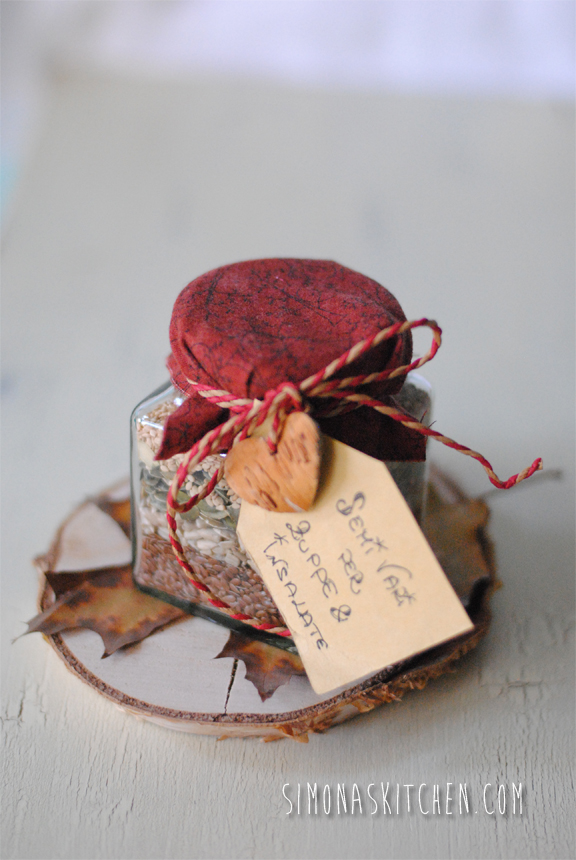(ENGLISH VERSION'S FORWARD)
La recette en Français est vers le bas
Mi ricollego oggi, al discorso avviato qualche giorno fa sui prodotti artigianali della mia città, oggi vi parlo di wurstel artigianali e di porchetta!
Il wurstel in versione artigianale è diverso da quelli che
siamo soliti trovare nei banchi frigo della grande distribuzione.
Sue Ellen del
Salumificio Mannori mi ha raccontato ad
esempio, che quelli che producono loro da circa un anno, sono senza
conservanti, fatti solo con carni selezionate e magrissime, con una percentuale
di grassi molto bassa.
Le parti di carne utilizzate non sono scarti bensì parti
magre della coscia e della spalla.
Cotti con sale e pepe e confezionati, prevedono un’ulteriore
cottura da parte del consumatore, ma possono esser mangiati anche così, al
naturale.
Grigliati o bolliti, si accompagnano con salse tipo il
ketchup o la senape, di cui vi lascio una versione sperimentata da me, chiamata
‘Senape Casereccia’.
Il panino con la Porchetta è uno del street food più
diffusi nella zona tra Prato e Pistoia.
La porchetta è la pancia del maiale, compreso il filetto e
la pancetta.
Aromatizzata e legata, viene poi cotta in forno per ben 13
ore.
Il ‘Battuto’ usato per insaporire la carne è a base di sale,
pepe, finocchio ed aglio, la cottura avviene lentamente ed in forno a bassa
temperatura, così che si formi la crosticina croccante.
Dentro alla carne viene inserito un ripieno a base di fegato
di maiale.
ENGLISH VERSION
There’s a
little butcher here in Prato, that produces several typical saussages and
since one year, also produces wurstels.
Sue EllenMannori, the owner’s daughter, told me about their production and special
details that are their quality recognitions!
They start
with selecting fat low pork, only pork leg and shoulder, then proceed with
cooking.
Their
wurstel have no preservatives and are cooked with a very slow procedure, with
salt and pepper, no other chemical additives.
Consumers
will decide whether eat them naturally or grilling or boiling, combining with
sauces such as mustard or ketchup.
In Italy
and Tuscany expecially, you’ll find small kiosks on the edges of roads, with a
written advice that sounds more or less ‘panino con la porchetta’ trad. Means
‘porchetta sandwich’.
Porchetta
is infact a very common street food, it’s the ‘belly’ of the pork (arista and
pancetta), roasted and served into a soft bread.
One of the
best porchetta I’ve ever tried is the one I’m going to tell you (HERE le link
to the producer).
Before
cooking, they use to spred pork with a mix made of salt, pepper, fennel seeds
and garlic.
It’s cooked
very slowly (13 hours) at a very low temperature so to make meat become tender
and the crust to become crunchy.
The filling
of porchetta is made of pork liver.
La recette en Français
La version
artisanal des wurstel est trés different par les quelles nous achetons au
supermarché.
Sue Ellen
du Salumificio Mannori m’a expliqué par example, les wurstel qu’ils produisent
sont sans additifs, ils utilisent seulement parties maigres du porc et ils ont
une pourcentage trés basse de gras.
Les parties
du porc qu’ils utilisent ne sont pas des déchet mais parties sélectionnés, cuisse
et épaule.
Ils sont
cuits avec du sel et du poivre et on peut les manger nature ou grilles.
Je vous
laisse un link à une des mes recettes, une Moutarde trés facile.
Le sandwich à la porchetta est un des plus typiques street
food de ma region (Prato et Pistoia).
La porchetta est le ventre du porc, arista plus pancetta.
Il est aromatisé et lié et il est cuit lentement, au four
pour 13 heures, basse temperature, la croute devient croquante.
Le mix des épices utilisées est à bas de sel, poivre,
fenouil et ail, le rembourrage est du foie de porc.





